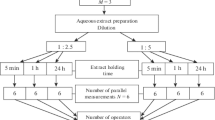Abstract
The testing process determines the specified characteristics of an object. Testing is commonly used to verify the quality, safety, reliability, efficiency, and environmental sustainability of products and services. In Brazil, the National Institute of Metrology, Quality and Technology (Inmetro) is responsible for accrediting the facilities that undertake testing and calibration activities. Typical accredited testing services include: water quality, clinical tests, emissions tests, and vehicle safety tests. Undertaking fraudulent behavior when testing processes can result in products that are dangerous to the ordinary citizen and to the environment. Further, fraudulent behavior produces unfair competition between concurrent organizations. This paper presents a method to detect possible fraudulent behavior in accredited testing facilities. The proposed technique combines the bootstrap method and the Dempster–Shafer theory of evidence, to investigate several fraudulent aspects at once. To validate the proposed method, we use a Brazilian real-world dataset with real cases of fraud. The proposed technique successfully detects the accredited testing facilities with fraudulent behavior.

Similar content being viewed by others
References
Behdad M, Barone L, Bennamoun M, French T (2012) Nature-inspired techniques in the context of fraud detection. IEEE Trans Syst Man Cybern C 42:1273–1290
Souza RP, Carmo LFRC, Pirmez L (2014) Detecção de Dados Suspeitos de Fraude em Organismos de Inspeção Acreditados. XIV Simpósio Brasileiro em Segurança da Informação e de Sistemas Computacionais. http://www.sbseg2014.dcc.ufmg.br/files/anais.pdf. Accessed 6 Nov 2014
de Souza RP, Carmo LFRC, Pirmez L (2016) A procedure to detect suspected patterns of fraudulent behavior in vehicle emissions tests performed by an accredited inspection body. Accred Qual Assur 21:323. doi:10.1007/s00769-016-1231-y
Manly BFJ (2006) Randomization, bootstrap and Monte Carlo methods in biology, Chapman and Hall, New Zealand, USA ISBN 978-0-412-36710-6
Taylor RN, McEntegart DJ, Stillman EC (2002) Statistical techniques to detect fraud and other data irregularities in clinical questionnaire data. Drug Inf J 36:115–125
Wu X, Carlsson M (2011) Detecting data fabrication in clinical trials from cluster analysis perspective. Pharm Stat 10:257–264
Kirkwood AA, Cox T, Hackshaw A (2013) Application of methods for central statistical monitoring in clinical trials. Clin Trials 10:783–806
Ge Y, Xiong H, Liu C, Zhou Z (2011) A taxi driving fraud detection system. In: IEEE 11th international conference on data mining. doi:10.1109/ICDM.2011.18
Buyse M, George SL, Evans S, Geller NL, Ranstam J, Scherrer B, Lesaffre E, Murray G, Edler L, Hutton J, Colton T, Lachenbruch P, Verma BL (1999) The role of biostatistics in the prevention, detection and treatment of fraud in clinical trials. Stat Med 18:3435–3451
Devore J (2012) Probability and statistics for engineering and the sciences. Cengage Learning, Boston, USA. ISBN-10: 0-538-73352-7
Montgomery DC, Runger GC (2010) Applied statistics and probability for engineers. Wiley, Massachusetts, USA. ISBN–13: 978-0-470-05304-1
Efron B (1979) Computers and the theory of statistics: thinking the unthinkable. SIAM Rev 21:460–480
Efron B, Tibshirani RJ (1993) An introduction to the bootstrap. Monographs on statistics and applied probability, Vol. 57, Chapman & Hall, London, UK. ISBN-10: 0412042312
Wehrens R, Putter H, Buydens LMC (2000) The bootstrap: a tutorial. Chemometr Intell Lab 54:35–52
Good P (1994) Permutation tests: a practical guide to resampling methods for testing hypotheses. Springer, New York, USA. ISBN 978-1-4757-2348-9
Kay RU (2007) Fundamentals of the Dempster–Shafer theory and its applications to system safety and reliability modelling. Reliab Theory Appl 3:173–185
Croucher JS (2004) An upper bound on the value of the standard deviation. Teach Stat 26:54–55
Dong F, Shatz SM, Xu H (2009) Inference of online auction shills using Dempster–Shafer theory. In: Sixth international conference on information technology, New Generations. doi:10.1109/ITNG.2009.28
Downey AB (2014) Think stats: probability and statistics for programmers. Green Tea Press, Massachusetts. ISBN-10: 1449307116
Acknowledgements
The authors would like to thank the National Institute of Metrology, Quality and Technology of Brazil for its support.
Author information
Authors and Affiliations
Corresponding author
Ethics declarations
Conflict of interest
The authors declare that they have no conflict of interest.
Rights and permissions
About this article
Cite this article
de Souza, R.P., Carmo, L.F.R.C. & Pirmez, L. An enhanced bootstrap method to detect possible fraudulent behavior in testing facilities. Accred Qual Assur 22, 21–27 (2017). https://doi.org/10.1007/s00769-016-1245-5
Received:
Accepted:
Published:
Issue Date:
DOI: https://doi.org/10.1007/s00769-016-1245-5




